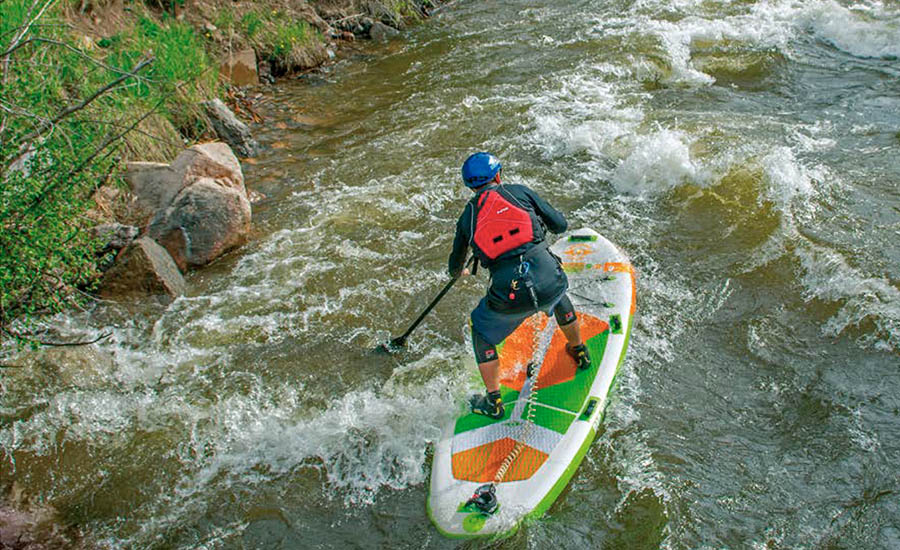Highly user friendly, and constantly gaining popularity, SUPing has taken over the coastal surf and race cultures, the flatwater fitness arena and is now moving inland, where it is rapidly establishing itself in the whitewater scene.
For those confident on their boards who live far from the swells of the coast, the river is a natural venue for their next progression. As paddlers pursue new challenges, board technology strives to match. The evolution currently happening within whitewater SUP is driving the future and progression of the sport as river friendly board materials and designs influence the SUP community as a whole.
What is it about Whitewater that makes it the new “El Dorado” of SUP? “To put it simply, Whitewater SUP is ridiculously fun!” Says Hala Gear Founder and CEO Peter Hall. “People are realizing the water in their own backyard can be an untapped resource for adventure. The calmer rivers that many people have near their home are becoming a playground for surfing, balance, and expression. While these class 2+ rivers wouldn’t be as thrilling on another watercraft, they are an enjoyable challenge on a paddleboard. And as people grow in their skill, there are many new waterways and levels of intensity that they can take on.”
Rivers, like the SUP scene itself, offer endless adventure options from gentle class two through challenging class three/four, to surf waves in various sizes. You don’t need to be a stunt man or hard core thrill seeker to enjoy paddling downstream.
American born Hala Gear Sup has been a vanguard of the whitewater SUP revolution, one of the first brands to introduce a high volume inflatable board and a whitewater specific inflatable board. When asked what it takes for a board to be considered “whitewater specific” Founder and Ceo Peter Hall pinpoints stability, maneuverability, durability, and a rocker profile. Whitewater SUP Pioneer Dan Gavere identifies the importance of width and contact points, preferring “…a wide board in the 33-36 inch zone with a wide tail, and handles all over it so its easy to flip over and climb back on.” Because, as Soul Designer Corran Addison admits, “We all fall.” Soul’s designs seek to lower paddler’s center of gravity for increased stability while embracing the challenge of whitewater SUP with cheeky product names like the “BitchSmack.”
Many whitewater boards are built with PVC drop stitch for increased rigidity and durability in demanding environments. Hala and other companies are experimenting with adding carbon to inflatable boards as a way to further increase rigidity and performance. Unique to Hala is their “StompBox” retractable fin system, which solves the dilemma of needing a fin to track and turn effectively, but risking the “superman” effect of hitting an obstacle, stopping short, and being ejected. Other boards, like the Starboard Stream, feature removable fins so “you can paddle shallow rivers with different sized fins and really fine-tune your paddling experience,” says team rider Dan Gavere. These innovations benefit every style of Stand Up Paddling and will likely continue to shape the evolution of SUP design.
Rivers also permit inland surfing. Scattered across the US and Europe lay man-made play parks and standing surf waves that are flooding with SUP surfers. It is difficult to deny the ease and appeal of “park and play” style river surfing. Standing waves are consistent, predictable, and offer the perfect venue to rapidly improve skills. For Peter Hall, the influence of these parks is undeniable. “The rise of these parks not only brings a new source of revenue to the towns where they’re installed, but also creates a new resource to play in the outdoors. SUP paddlers are using them to create a distinctive culture of their own. They gather people together to learn from one another and grow this sport into the mainstream.” A nascent freestyle SUP progression exists here, drawing influence from kayaking and surfing, blending tricks, styles and sport history. Moves like “spins” and “shuv-its” show off SUP board control, while the pleasure of simply standing and carving on a wave remains as pure on the river as on the ocean.
“Whitewater SUP is barely a decade old,” reminds Corran. “As designs improve, skills improve, especially when young paddlers start to really get involved. The sport will only continue to experience technical revolutions. When that happens, we’ll really see what can be done.” It is no wonder we will soon be hard pressed to find a Stand Up company that doesn’t include a whitewater board in their collection.
By: Anna Bruno, Kayak Session, Paddle World and Sup World Mag editor.


